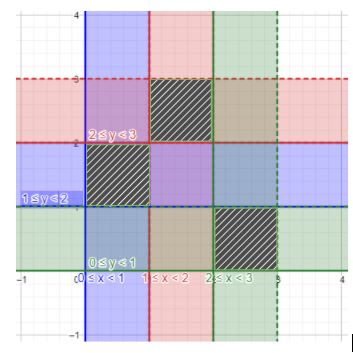
If $x\ge 0$ and $y\ge 0$ then the area bounded by the graph of $\left[ x \right]+\left[ y \right]=2$ (where $\left[ . \right]$ denotes greatest integer function).
(a)6 sq.unit
(b)1 sq.unit
(c)2 sq.unit
(d)3 sq.unit
Answer
577.8k+ views
Hint: $\left[ . \right]$ is representing greatest integer and $\left[ x \right]=c$ then x will lie in $\left[ c,c+1 \right].$ So, get the range of possible x and y for problem. Now, observe the values of x and y and get the curve of each observed case as a square. And use the result:
Area of a square $={{\left( side \right)}^{2}}$
Complete step-by-step answer:
Here, given equation in the problem is
$\left[ x \right]+\left[ y \right]=2........\left( 1 \right)$
And we are also given that $x\ge 0$ and $y\ge 0$.
Now, as we know greater integer function will always give an integer lying left to the given number on the number line. So, we can observe that $\left[ x \right]+\left[ y \right]=2$. So, $\left[ x \right]$ and $\left[ y \right]$ will be non-negative integers as $x\ge 0$ and $y\ge 0$. So, the possible values of $\left[ x \right]$ and $\left[ y \right]$ are given as:
(1)$\left[ x \right]=0,\left[ y \right]=2$
(2)$\left[ x \right]=1,\left[ y \right]=1$
(3)$\left[ x \right]=2,\left[ y \right]=0$
Now, as we know, if $\left[ x \right]=c,$ then x should lie in between the range $\left[ c,c+1 \right]$. So, we can write the above case as
(1) $0\le x<1$ and $2\le y<3$
(2) $1\le x<2$ and $1\le y<2$
(3)$2\le x<3$ and $0\le y<1$
Where we need to take care of the domain of ‘x’ and ‘y’ i.e. $x\ge 0$ and $y\ge 0$.
Now, as we need to find the area of the regions represented by all the three cases as given above. So, we can observe in the below graph, all the three cases are represented by the shaded region. Therefore, on close observation, we get that ‘x’ and ‘y’ are of unit length in each case.

Hence, the curve form in each of the cases would be a square. And as we know area of square is given as: Area of square $={{\left( side \right)}^{2}}$
So, the area of curves in each case would be $1\times 1=1uni{{t}^{2}}$. Hence, total area in all three cases would be
$1+1+1=3uni{{t}^{2}}$
So, 3 square units is the correct answer of the given problem.
So, the correct answer is “Option (d)”.
Note: One need not to draw a graph of the given cases in the solution. As, it can be clearly observed that ‘x’ and ‘y’ are defined for one unit length. So, they will form a square of one unit area.
One may draw the curve of equation $x+y=2$ (a straight line), which is wrong. So, don’t confuse yourself with this equation.
Area of a square $={{\left( side \right)}^{2}}$
Complete step-by-step answer:
Here, given equation in the problem is
$\left[ x \right]+\left[ y \right]=2........\left( 1 \right)$
And we are also given that $x\ge 0$ and $y\ge 0$.
Now, as we know greater integer function will always give an integer lying left to the given number on the number line. So, we can observe that $\left[ x \right]+\left[ y \right]=2$. So, $\left[ x \right]$ and $\left[ y \right]$ will be non-negative integers as $x\ge 0$ and $y\ge 0$. So, the possible values of $\left[ x \right]$ and $\left[ y \right]$ are given as:
(1)$\left[ x \right]=0,\left[ y \right]=2$
(2)$\left[ x \right]=1,\left[ y \right]=1$
(3)$\left[ x \right]=2,\left[ y \right]=0$
Now, as we know, if $\left[ x \right]=c,$ then x should lie in between the range $\left[ c,c+1 \right]$. So, we can write the above case as
(1) $0\le x<1$ and $2\le y<3$
(2) $1\le x<2$ and $1\le y<2$
(3)$2\le x<3$ and $0\le y<1$
Where we need to take care of the domain of ‘x’ and ‘y’ i.e. $x\ge 0$ and $y\ge 0$.
Now, as we need to find the area of the regions represented by all the three cases as given above. So, we can observe in the below graph, all the three cases are represented by the shaded region. Therefore, on close observation, we get that ‘x’ and ‘y’ are of unit length in each case.

Hence, the curve form in each of the cases would be a square. And as we know area of square is given as: Area of square $={{\left( side \right)}^{2}}$
So, the area of curves in each case would be $1\times 1=1uni{{t}^{2}}$. Hence, total area in all three cases would be
$1+1+1=3uni{{t}^{2}}$
So, 3 square units is the correct answer of the given problem.
So, the correct answer is “Option (d)”.
Note: One need not to draw a graph of the given cases in the solution. As, it can be clearly observed that ‘x’ and ‘y’ are defined for one unit length. So, they will form a square of one unit area.
One may draw the curve of equation $x+y=2$ (a straight line), which is wrong. So, don’t confuse yourself with this equation.
Recently Updated Pages
Why are manures considered better than fertilizers class 11 biology CBSE

Find the coordinates of the midpoint of the line segment class 11 maths CBSE

Distinguish between static friction limiting friction class 11 physics CBSE

The Chairman of the constituent Assembly was A Jawaharlal class 11 social science CBSE

The first National Commission on Labour NCL submitted class 11 social science CBSE

Number of all subshell of n + l 7 is A 4 B 5 C 6 D class 11 chemistry CBSE

Trending doubts
What is meant by exothermic and endothermic reactions class 11 chemistry CBSE

10 examples of friction in our daily life

One Metric ton is equal to kg A 10000 B 1000 C 100 class 11 physics CBSE

1 Quintal is equal to a 110 kg b 10 kg c 100kg d 1000 class 11 physics CBSE

Difference Between Prokaryotic Cells and Eukaryotic Cells

What are Quantum numbers Explain the quantum number class 11 chemistry CBSE




